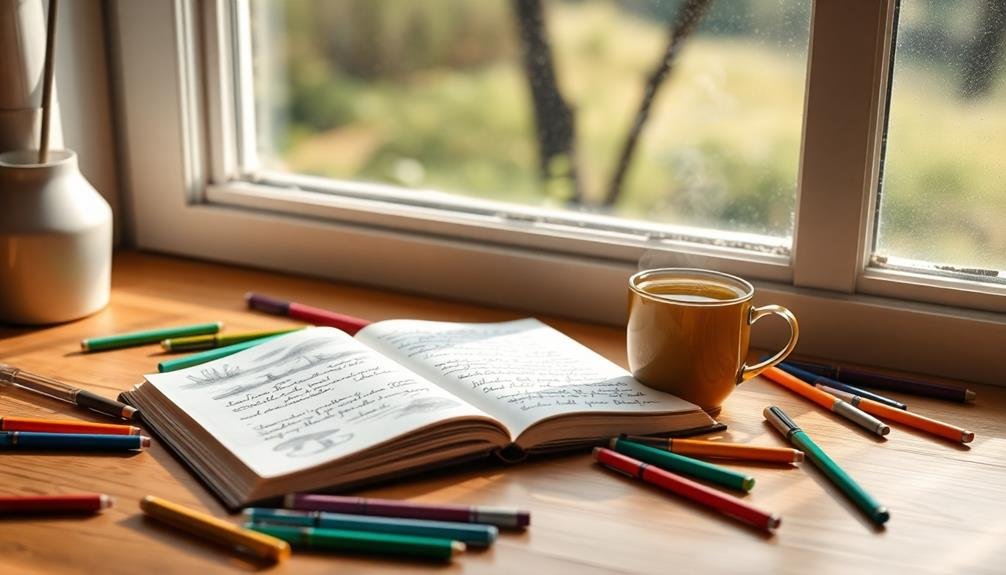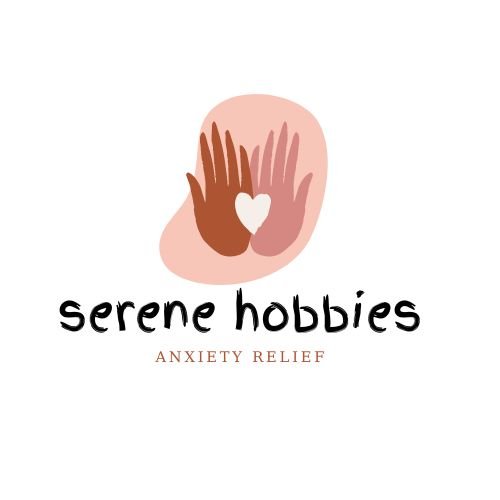To tame your worries, try these five powerful writing techniques. Start with stream of consciousness writing to release your thoughts without worrying about grammar. Next, practice gratitude journaling by listing three to five things you're thankful for each day to shift your mindset. You can also engage in prompted journaling exercises that encourage you to explore your worries and identify possible solutions. Letter writing allows for emotional release, while visual journaling combines images and words to express feelings creatively. Each technique offers unique insights, and you'll soon find that your worries don't seem so overwhelming after all.
Stream of Consciousness Writing

Have you ever felt overwhelmed by your thoughts, like they're racing ahead without a clear destination? Stream of consciousness writing can help you untangle those swirling ideas and bring clarity to your mind. This technique encourages you to write continuously, capturing every thought that comes to you without filtering or editing.
It's all about letting go of inhibitions and simply putting pen to paper or fingers to keyboard.
To get started, find a quiet space where you won't be disturbed. Set a timer for 10 to 15 minutes, and begin writing whatever comes to mind. Don't worry about grammar, punctuation, or coherence; just let your thoughts flow freely.
You might discover connections between ideas you hadn't noticed before, or even uncover underlying worries that need addressing.
When the timer goes off, take a moment to read what you've written. You might be surprised by the insights you'll gain. This process not only helps you release pent-up thoughts but also offers a fresh perspective on your worries.
Gratitude Journaling
Gratitude journaling offers a powerful way to shift your focus from worries to appreciation. By taking a few moments each day to jot down what you're thankful for, you create a positive mindset that combats anxiety. Instead of dwelling on what's wrong in your life, you'll start to recognize the abundance around you.
To begin, grab a notebook or open a digital document. Set a timer for five or ten minutes and write down three to five things you appreciate. They can be big or small—maybe it's the warmth of the sun on your skin or a supportive friend. As you write, really feel the gratitude for each item. This practice not only boosts your mood but also reinforces a habit of looking for the good in your life.
Consistency is key. Try to make gratitude journaling a part of your daily routine, whether it's in the morning or before bed. Over time, you'll find that your worries shrink as your appreciation grows.
This simple technique helps you cultivate a more positive outlook, reminding you that even amidst challenges, there's always something to be thankful for.
Prompted Journaling Exercises

Prompted journaling exercises can be a valuable tool for tackling worries and gaining clarity. By responding to specific prompts, you can focus your thoughts and explore the root causes of your concerns. Start with a simple question like, "What's been on my mind lately?" This helps you pinpoint your worries and understand them better.
Another effective prompt is, "What can I control in this situation?" This encourages you to identify actionable steps, empowering you to shift your mindset from feeling overwhelmed to feeling proactive. You might also try asking, "What's the worst that could happen?" This exercise helps you confront your fears directly, often revealing that they're less intimidating than they seem.
To deepen your reflection, consider prompts like, "What have I learned from this experience?" or, "How can I view this situation differently?" These questions help you gain perspective and foster resilience.
Letter Writing for Release
Writing letters can be a powerful way to release pent-up emotions and worries. When you put pen to paper, you create a safe space to express your thoughts freely.
Don't worry about grammar or how it sounds; focus on what you feel. Write to someone specific, or even draft a letter to yourself. This act allows you to confront your worries directly.
Consider starting with a simple greeting, then immerse yourself in what's bothering you. Describe your feelings in detail. Use vivid language to paint a picture of your emotions. By articulating your worries, you give them a voice, making them easier to manage.
Once you've poured out your heart, you might decide what to do with the letter. You could keep it, revisit it later, or even burn it as a symbolic gesture of letting go.
The act of writing can help you process emotions, turning chaos into clarity.
Visual Journaling Techniques

Visual journaling techniques offer a creative outlet for expressing your worries, allowing you to combine images with words to capture your emotions. When you pick up that pen or paintbrush, you're not just creating art; you're engaging in a therapeutic process.
Start by selecting a theme for your journal entry. It could be a specific worry or a general feeling.
Next, let your intuition guide you. You might doodle, sketch, or collage images that resonate with your emotions. Don't worry about artistic skill; focus on what feels true to you.
Once you've created your visual piece, add words or phrases that reflect your thoughts. This could be a short poem, a stream of consciousness, or simple affirmations.
Frequently Asked Questions
How Can Writing Improve Mental Health and Reduce Anxiety?
Writing helps you process emotions, clarifying thoughts and easing anxiety. When you express feelings on paper, you create distance from worries. It's a therapeutic outlet, allowing you to confront challenges and foster a sense of control.
What Materials Are Best for Visual Journaling?
For visual journaling, you'll want quality paper, vibrant markers, colored pencils, or watercolors. Stickers and stencils can add fun, while a sturdy journal will keep your creations safe. Experiment and find what inspires you!
Can Journaling Replace Therapy for Anxiety Management?
Journaling can't fully replace therapy for anxiety management, but it can complement it. You'll find clarity and emotional release through writing, helping you process thoughts. Still, professional guidance is essential for deeper issues.
How Often Should I Practice These Writing Techniques?
You should practice these writing techniques regularly, ideally daily or several times a week. Consistency builds habit and deepens your understanding, allowing you to explore your thoughts and feelings more effectively over time.
What Is the Best Time of Day to Write?
The best time of day to write depends on when you feel most inspired and focused. If you're a morning person, rise early; if you thrive at night, embrace those quiet hours. Find your rhythm!
In Summary
By embracing these powerful writing techniques, you can transform your worries into a source of clarity and strength. Whether you choose to let your thoughts flow freely, express gratitude, or engage in creative exercises, each method offers a unique path to understanding and releasing your anxieties. So grab a pen, find your voice, and start your journey toward a calmer mind. You've got the tools you need to reclaim your peace and empower your thoughts.





Leave a Reply